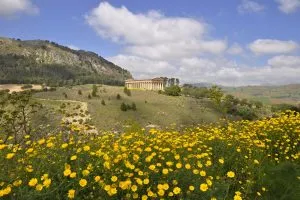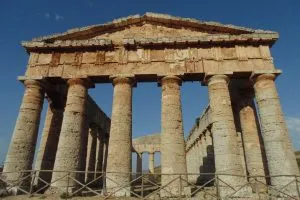THIS TOUR IS ONLY OFFERED IN COMBINATION WITH OTHER SERVICES INCLUDING TRANSPORTATION FROM OTHER SICILIAN CITIES
Segesta Walking Tour with Private licensed local Guide
Visit the archaelogical park of Segesta (Admission fee: not included) with a private licensed local Guide. The magnificent Doric Temple, built before 430 BC, is the focal point of the park. The amphitheatre is not very large but still impressive and offers a high vantage point from which to view the surrounding valleys. Segesta was one of the major cities of the Elymian people, one of the three indigenous peoples of Sicily.
The appointment will be set directly at the ticket office. More details will be provided at time of booking.
Please note:
The Guide will be at Your disposal for maximum 3 hours.
TRANSPORTATION:
Private transportation is not included in this service. In case you do need to move using cab (taxi) feel free to ask to the Local Guide to help you to orchestrate this service. You can pay the amount cash on the spot.
LICENSED LOCAL GUIDE:
This walking tour does include Licensed Local Guide.
MAXIMUM GROUP SIZE: 50 people
LANGUAGE:
Italian, English, French, Spanish, German.
Subject to availability at time of booking.
TOUR DETAILS & BOOKING INFORMATION
ADMISSION FEE:
The price of this walking does not include the Admission Fees (entrance payable on the spot). If you are under 18 years old the admission fees are free of charge for you showing your document (or copy of your document) on the spot.
DISABLED TRAVELERS:
Disabled Travel are not recommended for a walking tour.
AS REGARDS SEGESTA:
Segesta’s ancient Greek temple can make a valid claim to being the best preserved in the world, and its amphitheatre boasts a hilltop position on Mount Barbaro second to none. The archeological site, about seventy kilometers southwest of Palermo, reflects the presence of several ancient civilizations, beginning with the elusive Elymians. While the magnificent Doric temple, though (strictly speaking) never completed – as the roof was never added and the pillars never fluted – is impressive, it is just the highlight of a large archeological park.
Truth be told, precious little is known of the Elymians (or Elymi), founders of the place initially called Egesta. Originally from Asia Minor (possibly Anatolia), they arrived in Sicily to settle some of the island’s western regions around 1200 BC (BCE), during more-or-less the same period that the Sicels, migrating from peninsular Italy, colonised the northeastern part of the island. Both coexisted with the indigenous Sicanians. During the Greek domination which began circa 600 BC most of the Elymians, including those of Egesta, Entella and other settlements, readily assimilated with Greek culture. Evidence suggests that the Elymians of Eryx, however, assimilated more with Punic (Carthaginian) culture.
This all seems rather arcane, but inscriptions in what is presumed to be the Elymian language, written in Phoenician and Greek characters, have been found at Segesta, along with pieces of pottery bearing script similar to that of a specific region of Asia Minor. The Greeks freely intermarried with the Elymians, but initially prohibited marriage with the Sicanians, who they considered barbarians.
Segesta emerged as one of the most important Siceliot (Sicilian-Greek) cities of antiquity. The Segestans themselves were a formidable force both economically and militarily. The hilltop site of the ancient city was inhabited into the Middle Ages, and boasts the crumbling ruins of a Norman castle, a small church and a mosque, along with a classical amphitheatre.
Built before 430 BC, the Doric temple is the focal point of Segesta. The temple is just over sixty meters long and twenty-six meters wide, built upon four steps, with a total of thirty-six Doric columns. There are fourteen columns on each side of the building and six columns across the front and back.
At a diameter of around sixty-two meters, the amphitheatre is not very large but still impressive. It offers a high vantage point from which to view the surrounding valleys.
A colorful theory is widely accepted which advances a reason for the temple’s construction. In 450 BC, Segesta’s rival, Selinunte, allied herself with Syracuse, one of the most powerful city-states of Magna Graecia. Segesta sought help outside Sicily, turning to Athens for aid. To the Athenians, Segesta was only a distant city of little importance. Before they would consider an alliance with Segesta they sent a delegation of diplomatic envoys to investigate the city’s claims of wealth. In order to deceive the Athenians into thinking their city more prosperous than it actually was, the Segestans built the temple to impress their visitors. Once the envoys departed, convinced of Segesta’s wealth, work on the Temple ceased. Yet its incompleteness cannot compromise its grandeur.
Though founded centuries earlier, the recorded history of Segesta begins around 500 BC. The Greek colony of Selinunte, just sixty kilometers south of Segesta, had dramatically grown and prospered since its founding around 650 BC. This alarmed the Segestans, who initially welcomed the Greeks but later viewed the rapidly expanding power of Selinunte as a serious threat. Likewise the Carthaginians, whose cities were spread from Mozia, near present-day Marsala, to Solunto, viewed the Greeks as a double-edged menace rapidly approaching them on two fronts – Himera on the northern coast and Selinunte on the southern one. Segesta allied itself with Carthage. However, with the great victory of the combined Greek armies over the Carthaginians at Himera in 480 BC, the Segestans quickly changed sides, becoming allies of Athens, one of the victorious Greek cities. (The Greeks often fought among themselves; the Greek colonies in Sicily were rarely united and had been founded by Greeks from various cities in Greece).
If medieval chronicles all but ignore Segesta, in ancient ones she is little more than a footnote to epic conflicts. Yet in places like Segesta, certain things seem to have changed little in many centuries. Paestum has grassy fields, Agrigento almond groves, and Segesta its grassy slopes.
What became of the Segestans? Nearby Calatafimi was essentially an Arab city of mosques and veiled women. Still, it is probable that the medieval Segestans abandoned their city for nearby towns such as Erice (Eryx). The ancient sculpture of Segesta leaves us with an idealized impression of a healthy, attractive people.
TOUR CODE: SEGWALK
- Category
- Location
- Days1
- Duration3 Hours
- CategoryWalking Tour
- Tour TypePrivate
- SeasonALL YEAR








